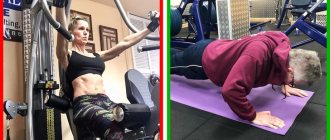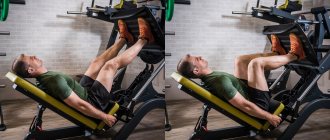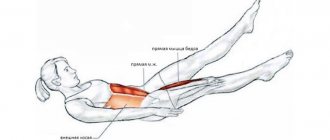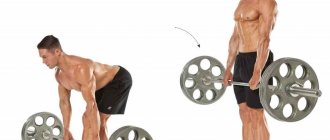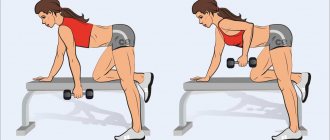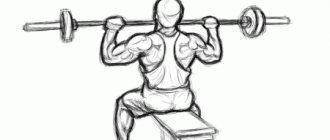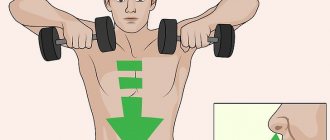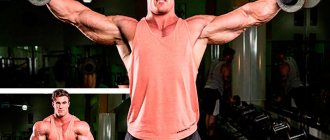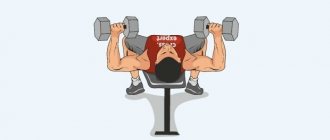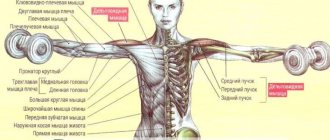According to statistics, every fifth person goes to the gym and monitors the condition of their body, as well as their nutrition. This useful activity strengthens the body, making it more powerful. This happens as a result of complex physical exercises, with which you can pump up your arms, back, and chest. But what kind of workouts strengthen muscles? The gym has a barbell, exercise machines, and a horizontal bar, but only an experienced person knows which of these is more effective.
Today we will talk about one of the exercises - dumbbell raises. You will learn all the nuances associated with it, as well as the harm that the wrong technique can cause. Let's find out what mistakes are most often made during execution and how to achieve maximum results.
What kind of exercise is this?
Dumbbell flyes are a powerful exercise. Experienced athletes perform it to maintain the proportionality of the upper shoulder girdle. During general training, the back of the deltas always lags behind, and in our case, 90% of the load goes directly to them. However, for it to really work, you need to follow the technique.
Often, a huge number of people pay a lot of attention to certain groups, but do not achieve the desired results. It’s a pity for beginners who have the motivation, but just don’t have enough knowledge. There is no promotion not because the performer is lazy or has no desire, but precisely because small but important details are not taken into account during the work.
This painstaking attitude to the technique of the exercise is explained by its complexity. It is performed in a standing or sitting position. In the first case, the body moves forward to an angle of 60 degrees, and in the second, everything is the same, only on a bench. It is done mainly to increase the volume of the shoulders at the back.
Main complex
Bent-over dumbbell flyes are not used as a mass-building exercise, but at the same time they are the basis for training the muscles of the back of the shoulder. The greatest effect from dumbbell rear delt raises can be achieved when combined with basic movements.
Training program for a 3-day split
When building a sports program, it is most often divided into 3 training days. On each of these days, a large muscle group and several smaller ones are necessarily included. There are other ways to organize a training split, but when creating a set of movements for 3 days, this principle is most often used.
For beginners, the best option would be to combine the pectoral muscles and deltas. At the same time, the order in which the days in a split follow each other is not of fundamental importance. This method of organizing training allows the athlete to load the front delts with heavy weights when bench pressing.
Consequently, this muscle group will receive its necessary portion of the load even before shoulder training. And the practitioner will have the opportunity to devote more time to the middle and rear beam.
Such a training program could look like:
- Lateral raises from a standing position 3 * 12-15 repetitions. This exercise is aimed at developing the middle bundle of deltoid muscles. When performing it, special attention must be paid to the position of the dumbbells in the hands. To isolate the target muscle, it is necessary to tilt the front part of the equipment slightly forward so that the little finger is slightly higher than the thumb. The elbow should be slightly bent.
- Inclined wiring 3*12-15 times. If there is a disproportion in development and there is a clear predominance of the middle beam over the back, then the exercises can be swapped.
Classic two-day split
With a 2-day split, 2 workouts are performed in a row. They are followed by 1 day of rest. Then the cycle repeats. In this case, the athlete conditionally divides his body into two parts. The lower body and abs are done on the first day, and the upper body on the subsequent day.
This method of organizing the training process is optimal for those who are just starting to work out in the gym. You can practice it for up to 2-3 months. After this, the magnitude of the load will increase so much that the body will no longer be able to recover after sports activities.
For a two-day split, bent over dumbbell flyes can be used as a second shoulder exercise. At the same time, you should perform it with light weight, trying to feel the working muscle group.
| Overhead barbell press 4* (8-10 reps) | This is a heavy compound movement that engages all the deltoids. The main work is performed by the anterior delta, and the posterior and middle beams are assigned an auxiliary role. The overhead barbell press can be performed from a standing or seated position. |
| Bent-over dumbbell flyes supported on a bench 3* (12-15 times) | This type of exercise is suitable for a two-day split. After performing pull-ups, presses and rows, there may be no strength left at the end of the workout. In such a situation, it is extremely difficult to perform standing dumbbell raises. It is important to choose the correct angle of the bench. It should be comfortable to lean on. As a rule, for people of average height and standard build, this angle ranges from 30 to 40 °C. |
It should be noted that these exercises are not interchangeable. They must be performed strictly in the specified sequence.
What muscles work?
Bent-over dumbbell swings are an isolation exercise by their nature. That is, if we take the bench press, then this is the base that involves large muscle groups: chest, shoulders, triceps, forearms, abs and others. But in our case, not a single group will work fully. When raising dumbbells to the sides, only individual parts function. Their list includes:
- The posterior delta bundles take on the main load.
- Trapezoid - 75% of work is included.
- Subosseous, rhomboid and teres minor muscles - they act synchronously with the deltoids and are auxiliary.
- Triceps, biceps, hands, leg and spine muscles, buttocks are stabilizers.
As you can see, individual muscle areas are activated. There are a lot of them, but the work they do is insignificant compared to the rear delts. With the right technique, they take on almost the entire load.
Common Mistakes
Since the dumbbell fly is aimed at training a specific individual muscle, even minor changes in it lead to a decrease in the effectiveness of the exercise. In this case, other muscle groups are loaded: the middle delta or trapezius muscle of the back, lower back. Often, beginners try to choose heavy dumbbells, which are inconvenient and dangerous for untrained people to work with. Beginning athletes make the following mistakes when performing bent-over dumbbell raises:
- Abduction of straight arms when performing the exercise. Then it is not the rear delta that works, but the spinal muscles.
- Unable to keep your back straight during exercise. It should be remembered that a deflection of the lower back and a straight back are required when performing swings.
- Insufficient tilt. Reducing the angle of inclination leads to a load on other muscles.
- Elbow position. They should be facing the ceiling, pulling back will engage the other area of the shoulder.
- Experiments with large masses. May cause injury. Sports equipment that is too heavy will not allow you to complete the required number of approaches. The large mass will not allow you to raise your arms to the required height, and you have to lower them faster.
- You should not knock dumbbells against each other, joining your hands when returning to the starting position, since the force of inertia begins to act on them. Then the hand does not experience the proper load and the effectiveness of training decreases.
- Bent-over raises with dumbbells should be done at a slow pace without jerking or acceleration.
At the initial stage of training, it is especially important to master the technique of performing swings. During this period, you should not strive to increase the number of approaches or the weight of the projectiles. Over time, athletes gain experience, begin to feel the necessary muscles, and perform the work “automatically.” To achieve this level, classes should be carried out systematically over a long period of time.
A common mistake newbies make is not tilting enough
The benefits and harms of exercise
If you look at it objectively, then any physical exercise is beneficial for the body. In our case, the following advantages stand out:
- A colossal load on the rear delts, which is why they are evenly worked out, and a beautiful relief appears.
- Strengthening the upper shoulder girdle, which reduces the risk of injury in the future.
- When performing, the upper back, as well as the arms, function.
- Strengthening the cuff of the shoulder joint, which is very often injured in bodybuilding.
That is, based on the above advantages, we can conclude that this exercise not only pumps up the back of the deltas, but also strengthens the shoulder nodes with ligaments, which are easily injured. This effect is achieved by an unusual movement - traction and expansion of the chest at the same time.
The only negative impact is on the vertebrae. When the performer does not strain his back, the discs begin to rub against each other and become worn out. That is, if the technique is incorrect, the exercise is not only ineffective, but also dangerous to health.
Contraindications
This exercise is not recommended for those with shoulder injuries. It is also worth paying close attention to the situation if injuries occurred and subsequently went away. With a heavy load there is a risk of relapse.
Do not lift dumbbells through pain. With the correct technique, only one thing is felt - a burning sensation in the rear delts. Try next time to just warm up more thoroughly and lift less weight.
In case of back injuries, it is better to avoid doing extensions in a standing position, since when bending upward, in addition to the shoulders, the spinal discs also work.
Consolidate the result
Bent-over dumbbell flyes are used in training to develop the posterior deltoid muscles. This is a small muscle group that is not used very often in everyday life. Due to its short length, it is difficult to increase it with stretching and gymnastics. You can additionally stimulate the rear delta to grow thanks to isometric tension.
To do this, you can take the starting position for breeding or perform the movement while standing. You should raise your elbows slightly, as required by the technique. Pull your arms back and fix them in this position for the maximum possible period of time. In this case, a slight tingling sensation in it will be a signal that the muscle is contracted to the maximum.
Technique and types of exercises
There are two types of dumbbell swings. The first is in a standing position and the technique for performing it is as follows:
- We take dumbbells with a working weight in our hands, go to the mirror and stand shoulder-width apart.
- When squatting, slightly bend your knees and lean forward with your even back to about 60 degrees.
- We place the dumbbells parallel to our feet, look at ourselves in the mirror and begin the lift.
- We make a slight bend in the arms at the elbow joints and fix it in this position.
- As you exhale, stretch your elbows toward the ceiling, while it is advisable not to squeeze your shoulder blades together.
- Raising your arms to parallel to the floor, slightly fix them in this position.
Here is an example in the video for better understanding:
The second way to raise dumbbells is in a sitting position:
- We take dumbbells, sit on a bench and move our legs together.
- With a straight back, bend over until your chest touches your knees.
- Then everything is the same as in a standing position - we make a slight angle at the elbows and stretch them towards the ceiling, spreading our arms to the side.
The latter method is much easier, since the work of the legs and lumbar stabilizers is eliminated. Also, we must not forget about the height of the bench. In any case, when your chest touches your knees, the angle between your straight back and the floor should be about 60 degrees. Then the maximum load will go to the rear deltoids. To better understand the meaning of this exercise, watch the video, which discusses the technique in detail.
Seated bent over fly
This exercise option is ideal for those who cannot keep their body straight and not sway. It allows you to stabilize the position and work more isolated:
- You need to take light dumbbells so that your palms face each other and the bars are parallel;
- Sit on the edge of the bench, place your arms along your body;
- Bend forward, placing your stomach and chest on your thighs;
- Raise your arms to the “forearm perpendicular to the spine” position;
- By contracting the rear deltas, perform a swing;
- Move your elbows up, not back;
- Lower the dumbbells
How many repetitions should I do? Typically, isolated non-strength exercises are done for 10-12 repetitions or more if more detailed muscle development is required. But you need to understand that athletes are individual, and more repetitions may be required if the predominant development of muscle fibers is different.
We always exhale with effort, so it should be done when the weight rises and not falls. It is a mistake to think that the athlete lowers the weight as he exits. True, it is in this position that it is difficult to breathe fully, since the chest lies on the hips and it will not be possible to draw a lot of air into the chest.
Example workout
At home
If you are not a professional athlete, then it is unlikely that you have a set of exercise machines and equipment at home. However, many people have weights, a pair of dumbbells, a horizontal bar, etc. Despite the narrow choice, achieving a good physique is possible. Let's look at a workout at home using just dumbbells. They must be selected based on your working weight. Now let’s warm up well and start working:
- Dumbbell bench press - to do this, you need to lie with your back on the floor, pick up the equipment and perform the exercise. You need to do 4 sets of 12 repetitions at a time without rest.
- Bent-over row - the body moves forward with a straight back, after which we pull the dumbbells to the lower abdomen. We do 4 sets of 12 repetitions, resting for a minute in between.
- Dumbbell push-ups - this element is performed like regular push-ups, only on a machine.
- Bent-over raises - pump up the rear delts with 4 sets of 12 repetitions with a minute of rest between each.
- Wide grip push-ups - do 4 sets of 12 reps without rest.
- Dumbbell row - instead of doing push-ups, you need to pull the dumbbell towards your belly button. We perform 4 sets of 12 times with a rest of 1 minute.
This is a simple home workout that will keep you physically fit and will not allow you to reduce the level of your abilities during the absence of professional training.
In the gym
When visiting the gym, a person probably follows a training program and it will be difficult to include a new exercise in it. But you can consider the option of pumping the rear deltas by drawing up an action plan:
- The bench press is a classic barbell lift on a flat bench. We perform 4 sets of 10 repetitions of the working weight with a minute of rest between them.
- Pull-ups - if you are able to do more than 20 reps, then it is better to add additional weight. In any case, we do it to failure.
- Crunches - we pump up the abs well, performing 4 sets of 20-25 repetitions.
- Bent-over dumbbell raises are the last thing we perform our exercise.
Please note that the workout worked major muscle groups, and we completed an isolation exercise at the end for maximum effect. It is important to follow this order of execution, since muscles grow from a hormone that is released during large loads in large groups. That is, there is no point in pumping up one rear delt without powerful training.
Benefits of Exercise
Bent-over weight raises allow you to achieve a round and sculpted shoulder shape. But this is not the only advantage. When doing the exercise regularly, the following happens:
- prevention of deltoid muscle injuries due to its uniform development;
- strengthens the muscles of the back, especially its upper part;
- strengthens the rotator cuff - a group of muscles and tendons responsible for stabilizing and rotating the humerus;
- the efficiency of performing bench presses, head presses, etc. improves.
Bent over dumbbell swings should not be done if you experience pain when moving your arms up and back. Most likely, you have damaged your deltoid muscle unnoticed, and you should wait until it heals before you start breeding.
Tips for implementation
Equipment
To feel comfortable during training, you first need to wear comfortable clothes. Most often, girls wear tight shorts with a T-shirt, and boys wear sweatpants and a T-shirt. Gloves will also come in handy to save you from blisters. It is advisable to take without fingers, as they are the most comfortable for the gym.
Sets and reps
For a man, the optimal value is 3-4 sets of 10-15 repetitions. For girls and women - the same number of approaches, only up to 10 repetitions. If you are losing weight or on a diet, you can reduce the weight to 2-3 kg and do it 20 times.
Common mistakes
They arise in technology due to incorrectly selected weight. When it’s hard for a person, he helps himself with inertial movements that reduce the load on the rear delts:
- Swinging movements of the body and legs.
- Curvature of the back when performing.
- Quickly lower the dumbbells down.
- Reduction of the shoulder blades at the top point.
- Change in the angle of the elbow joint.
- Fast pace of swings.
This is a list of the most common mistakes. To understand that the exercise is being performed correctly, it is enough to feel which muscles are working. Any action that makes the exercise easier is already a mistake.
conclusions
Dumbbell flyes are an effective exercise for pumping up the rear delts. It is better to do it after a hard, grueling workout. It is suitable for both boys and girls, and in terms of the number of repetitions it is no different from ordinary basic exercises. It is not recommended to perform it for shoulder and back injuries, but it is better to replace it with something. Particular attention should be paid to technique, since any deviation from the correct execution instantly makes it a useless exercise.
I hope you enjoyed reading the article about this wonderful exercise. In order not to get lost on the forums, you can subscribe to the newsletter and also share information with friends on social networks. That's all! I wish you good luck in your sporting endeavors.

